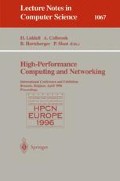Abstract
In this paper, we illustrate the way HPC application programs are developed using CORRELATE, a concurrent object-oriented language that supports applications for distributed memory systems. Our programming environment favours HPC applications because CORRELATE is a heterogeneous language that extends C++: on the one hand, CORRELATE objects can be coarse grained entities that exploit the language support because they model the concurrency aspects that are inherent to parallelism. On the other hand, each CORRELATE object can encapsulate C++ entities to implement its behaviour.
CORRELATE is a truly object-based language in that it enforces the application programmer to model an application as a collection of objects that interact by invoking operations on each other. Even though the development of commercial software is more and more dominated by the use of object-oriented technology for obvious reasons (ensuring that development efforts can be paid back in real sales), HPC applications are seldom built using OO language technology because of the potential overhead that is generated by an advanced object support system. The CORRELATE programming system attempts to deliver the best of both worlds by supporting concurrent objects as well as sequential objects. The latter can be implemented efficiently in C++, and concurrent objects simplify the modelling of interactions and synchronisation between high level application objects.
These aspects are illustrated by showing two CORRELATE implementations of an application in the area of molecular dynamics. The first example uses a coarse-grained approach in which subspaces of the simulated geometry are modelled as CORRELATE objects — and in that sense, these objects look similar to individual processes in SPMD programs. As an extreme, the second application models each particle as a CORRELATE object.
Preview
Unable to display preview. Download preview PDF.
References
Bob Bywater, Wouter Joosen, Stijn Bijnens, Pierre Verbaeten, Thomas Larsen, and John Perram. Parallel Simulation Software for Drug Design. In HPCN Europe 94, pages 189–196. Lecture Notes in Computer Science 796, Springer Verlag, 1994.
Stijn Bijnens, Wouter Joosen, and Pierre Verbaeten. Sender initiated and receiver initiated coordination in a global object space. In P. Ciancarini, O. Nierstrasz, and A. Yonezawa, editors, Object-Based Models and Languages for Concurrent Systems, LNCS, pages 14–28. Springer-Verlag, 1995.
Wouter Joosen, Stijn Bijnens, Bert Robben, Johan Van Oeyen, and Pierre Verbaeten. Flexible load balancing software for parallel applications in a time-sharing environment. In Bob Hertzberger and Giuseppe Serazzi, editors, High-Performance Computing and Networking, LNCS-919, pages 398–406. Springer-Verlag, 1995.
Hidehiko Masuhara, Satoshi Matsuoka, Takuo Watanabe, and Akinori Yonezawa. Object-oriented concurrent reflective languages can be implemented efficiently. In Proceedings OOPSLA '92, ACM SIGPLAN Notices, pages 127–XXX, October 1992. Published as Proceedings OOPSLA '92, ACM SIGPLAN Notices, volume 27, number 10.
Author information
Authors and Affiliations
Editor information
Rights and permissions
Copyright information
© 1996 Springer-Verlag Berlin Heidelberg
About this paper
Cite this paper
Joosen, W. et al. (1996). Affordable overhead in CORRELATE: Comparing two MD simulators. In: Liddell, H., Colbrook, A., Hertzberger, B., Sloot, P. (eds) High-Performance Computing and Networking. HPCN-Europe 1996. Lecture Notes in Computer Science, vol 1067. Springer, Berlin, Heidelberg. https://doi.org/10.1007/3-540-61142-8_551
Download citation
DOI: https://doi.org/10.1007/3-540-61142-8_551
Published:
Publisher Name: Springer, Berlin, Heidelberg
Print ISBN: 978-3-540-61142-4
Online ISBN: 978-3-540-49955-8
eBook Packages: Springer Book Archive

